EESE 4/2007
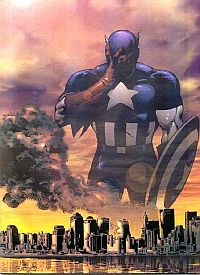
Source: Heroes, 7

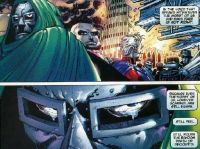
Source: Spiderman #36, 9

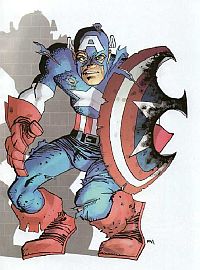
Source: Heroes, 9

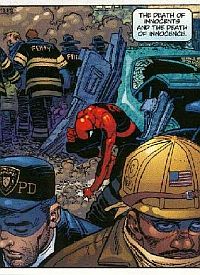
Source: Spiderman #36, 14[4]

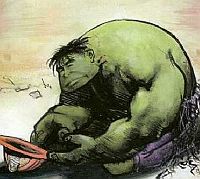
Source: Heroes, 1

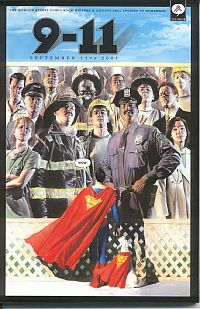
Source: 9-11: Artists Respond, Vol.1

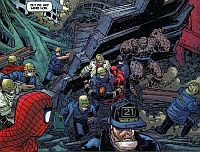
Source: (Heroes 4)Spiderman #36, 6[5]

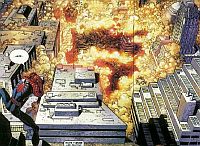
Source: Spiderman, 2-3

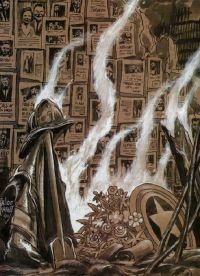
Source: Heroes, 4


Source: R. Heinze
Screenshot 00:11:45


Source: R. Heinze
Screenshot 00:37:26

Trauma, Morality & Conformity:
American (Super)Heroes After 9/11
Rüdiger Heinze (Freiburg)
|
Ooh Superman where are you now When everything’s gone wrong somehow The men of steel, the men of power Are losing control by the hour. (Genesis, "Land of Confusion") I think we all now realize that we do not have to read fiction to find examples of heroism. The real heroes of American life have been with us all along. (Rudolph W. Giuliani 2002)[1] The difficulty of listening and responding to traumatic stories in a way that does not lose their impact, that does not reduce them to clichés or turn them all into versions of the same story, is a problem that remains central to the task of therapists, literary critics, neurobiologists, and filmmakers alike. (Caruth 1995: vii) |
I. Stories To Remember
Comic book collections were among the first national-scale artistic representations of the trauma of 9/11. Soon after the events, the U.S.’s largest comic book publishers Marvel and DC both published collections with responses to the attacks by a number of artists. The first one, Marvel's Heroes, appeared in December 2001, with a subtitle that reads: "The world's greatest super hero creators honor the world's greatest heroes 9.11.2001." The second Marvel collection, A Moment of Silence, appeared in February 2002 with a foreword by former New York mayor Rudolph W. Guiliani, alongside a black edition of Spiderman (#36). These were shortly followed by DC's two volumes 9/11: Artists Respond (Vol. 1) and 9/11: The World’s Finest Artists Tell Stories To Remember (Vol. 2).[2] Among the most striking images from Heroes is Captain America towering above the devastated skyline of Manhattan in a posture of stunned sorrow, his legs standing in the place of the former towers (Fig. 1).
Similarly, in the black Spiderman edition, Spiderman stands poised and shocked looking at the ruins while being asked by survivors why the superheroes did nothing to prevent the attack. He can only answer: "We couldn't imagine" and that some things are "beyond words" and "beyond comprehension." In an unprecedented turn, towards the end of the strip even the supervillains mourn the loss of innocent lives (Fig. 2).[3]
Obviously, the collective trauma of the nation is also the trauma of its superheroes and their helplessness in the face of the tragedy. While many of the images do contain elements of a "still standing proud" sentiment, the superheroes are also shown as battered, dispirited, shocked; even the purportedly unbreakable shield of Captain America is frayed (Fig. 3; Fig. 4; Fig. 5).
Although Marvel originally discouraged the artists from drawing superheroes in order not to diminish the real-life heroes, the first collection Heroes primarily does show superheroes, though with a decisive twist. Their inability to prevent the attacks relegates them to the status of fictional helping hands for the real heroes: firemen, policemen, medics (Fig. 6; Fig. 7).
As a consequence of the tragedy and the propagated heroism of the human helpers, the superheroes apparently cannot be superheroes anymore, not only because they could not prevent the events –conflating actual and imaginary world– but also because their status is diminished by the heroism of people who do not possess super-human powers and whose efforts therefore have to be ranked more highly. Paradoxically, the concept of the superhero may allow for human weakness, failure and temporary loss of superhuman power but requires for the superhero to remain a super- and superhuman hero.
In order to resolve this dilemma, some of the most successful recent comic and film representations of superheroes render them more human and bring them closer to our actual, natural world (e.g. Spiderman, Batman, Daredevil, Wolverine), while others reinforce the status of their heroes as unequivocally super and superhuman (Superman, The Fantastic Four, Elektra, Hellboy). More attention will be paid to the former as they demonstrate greater moral ambivalence and more complex trauma negotiation. To be sure, all of them remain superheroes in accordance with the conventional strictures and formulas of their typical genres and media, lest they lose their appeal; but the first kind are portrayed as superhuman heroes who happen to also possess extraordinary powers.
It is no coincidence that artists who take this route focus on superheroes whose traditional comic book identity more readily lends itself to such humanization: Batman and Spiderman. Their portrayal, especially in the recent Blockbusters, displays a quirky but revealing invasion of the real and realistic into the fictitious and fantastic realm of the superheroes that links personal and collective trauma, private and public history, reality and fiction, thus putting unprecedented emphasis on the traumatic past and psychology of their heroes, over and beyond the convention of the troubled superhero. The Spiderman series and the recent Batman Begins are the first to explicitly and extensively foray into the traumatic past and character psychology of their protagonists, even before 9/11, while others (Superman, The Fantastic Four) almost entirely shirk such probing, and 9/11 on the whole. In the former, the audience is allowed a look into their original and continually relived trauma, their transformation, and their subsequent character development. The films focus on the moral dilemma and ambivalence brought about by the heroes’ role as vigilantes with a public and a secret identity, as avengers and tormented outsiders who aim to do good but are revengefully and remorselessly driven by their trauma. Similarly and for the first time as well, the supervillains in these films are complex: they suffer from chemically induced schizophrenia or a malfunctioning chip. Their character is ambivalent and not wholly negative: in the Spiderman series as well as in Batman Begins, the villains have their own trauma, and their atrocities are portrayed as, if not excusable, at least comprehensible.
Furthermore, contrary to the idea that these artistic reactions to 9/11 epitomize the need of "the 'average' American" to "escape from the very real horrors of international unrest and terrorism whose epic moment was September 11, 2001" (Roberts 210), I will argue that these superheroic representations and their intertwining of the real and the fantastic as well as the personal and collective trauma in fact are symptomatic responses to collective traumata and thus very much rooted in the real rather than an escape from it.[6]
In the following the essay will discuss the traumatic past and present of the superheroes and supervillains and the resulting moral ambivalences focusing on –for reasons of expediency–the Spiderman series and Batman Begins against the foil of the 2006 Superman adaptation and the backdrop of their 9/11 comic book representations, as well as their specific function as an aesthetic reaction to the national collective trauma of 9/11.[7]
II Beyond Words and Comprehension? Superheroes & Trauma
Almost all superheroes have their own personal trauma. They experience some personal catastrophe, e.g. the loss of family or other loved ones, or some other radical rupture of their life. Usually this trauma triggers their transformation from ordinary human into exceptional superhero, even if their superhuman powers antecede or are the result of their transformation. Even after awakening to his extraordinary abilities, Peter Parker is still Peter Parker until his uncle is killed. Only then does he act upon his uncle's last words that great powers entail great responsibilities and turns into Spiderman. Bruce Wayne is not endowed with superhuman powers but with a childhood trauma that provides him with the extraordinary (i.e. superhuman) motivation and will to seek revenge. In order to obtain this revenge, he uses his athletic skills, money and single-mindedness to turn into Batman. It is, thus, not necessarily their powers that turn them into superheroes, but their traumatic motivation.
This given, it may seem surprising that the specific circumstances and the history of that trauma are usually afforded little attention in either the original comic books or the earlier movie adaptations and thus all the more noteworthy that some of the contemporary adaptations do delve into the trauma history of their "patients/protagonists." One reason for the absence, at least for the figure of Batman, may be that his story, unlike Superman's, is "not an origin story: it's a mystery that is more concerned with the identity of the hero" (Newman 18). However, this is not true for Spiderman, Blade, Dare Devil or all the other superheroes. A more plausible reason may be that the aesthetic representation of personal and collective trauma is frequently considered problematic and potentially exploitative, an argument that was also leveled against the comic books mentioned above.[8]
All too often, as Kaplan and Wang point out, trauma is fixated upon as "the ultimate limit of representation" and as "inaccessible to understanding and imagery" (4), thus valorizing "the unthinkable, lack of witnessing, numbing, the unrepresentable, the absence of narrative, and failures in language" (4). This
[f]ixation on trauma leads to profound doubts about the viability of historical writing and its vehicles: narrative and image. Narratives and images designed to represent traumas are viewed with suspicion, for they seem to have the seductive power to gloss over the horrendous fact and to distort the literal truth of trauma. As trauma implies a shattering of a culture’s meaning-making scheme and representational modes, it is, as many critics insist, beyond the reach of representation. (La Capra 8)
In fact, the reason for this oscillation between the need to represent and the fear to represent is that traumatic experiences, whether personal or collective, create a double bind and are fundamentally different from common memory functions. Traumatic experiences, due to their experienced radical disruptiveness of things we take for granted, resist integration into language, narrative and images and point to the unrepresentable, yet they insist on their existence and their importance and consequently cannot be forgotten (Kopf 10). As studies and reports about immediate and later reactions by trauma victims show, they suffer from a dialectic between repressing and silencing terrible events and speaking about them (Ansprenger and Robertson 2004; Brenner 2004; Brockhaus 2003; Coates 2003). Victims have to negotiate a relationship between inside and outside world, personal suffering and 'history' or larger narratives, trauma and language. In other words, traumatic experiences stick in the mind precisely because they cannot be integrated into memory within a meaningful narrative of our selves (Kopf 33). Because there can be no closure, traumatic experiences continually compromise the present.[9] It is difficult for the victims to speak about trauma not only because there are no words for it but because the general sense and meaning of speaking about it is absent, there is no trust in the meaning of communication per se and of talking to others (Kopf 42). This is especially true for those traumatic events that are brought about by other humans rather than natural catastrophes, since here a general trust in humanity is potentially invalidated.[10]
In the face of such extreme experiences, aesthetic representations of them are understandably viewed with caution and suspicion. In a paradoxical twist typical of trauma representations, Spiderman, in one of the aesthetic renderings of 9/11 mentioned in the beginning, proclaims that some things are "beyond words" and "beyond comprehension." Yet we see a picture of him in a clearly artistic context looking at the incomprehensible (Fig. 8). As Martina Kopf argues, the legitimacy of an aesthetic rendering of extreme violence and traumatic experiences is repudiated because the events are so extreme; if they are represented, they are supposed to meet the most scrupulous standards of verisimilitude. However, those aspects of trauma that remain beyond words, language, narrative and images are constitutive factors of that violence whose realistic rendering is impossible. As a result, Kopf concludes, the representation of trauma inescapably remains, to some degree, fictitious (53). This does not inevitably diminish its legitimacy and necessity, on the contrary. If collective memories and the attempts to cope with trauma are "understood as forms of myth making," then "their significance lies less in their accuracy than in the meanings they have for adherents” (Neal 214). In fact, the artistic pictures offer the possibility to create an aesthetic and moral counter force/discourse to the pervasive media images (Anzieu-Premmereur 284).
Following Elaine Scarry’s assumptions, just as pain diminishes or deletes "world" or meaning, imagination creates world (Scarry in Kopf 28) so that one could argue that art creates meaning where traumatic events destroy it (31). Regarded in this manner, the comic book superhero reactions to 9/11, the mingling of reality and fiction, collective and personal trauma, appear not absurd but legitimate, e.g. in artworks such as in fig. 9.[11]
If we apply these ideas to the assumption that there is an invasion of the real into recent superhero representations, this new and unprecedented realism as well comes to seem more consistent than surprising. If the overwhelming collective trauma of 9/11 is understood as such, namely as having a lasting and radical impact on the collective memory of the U.S.A., on national narratives and myth making, on all cultural products and aesthetic representations of that specific trauma and trauma in general, it also becomes the trauma of its superheroes, as the comic poster books Heroes and A Moment of Silence vividly demonstrate.
Admittedly, not all of the recent movie adaptations explicitly address 9/11, some of them having been conceived before the event, e.g. Spiderman I and II. Also, focusing on September 11 alone elides the fact that Superheroes as a concept have been perpetually present in a variety of media for decades;[12] even their extraordinary movie revival can be said to commence in the 1990s long before 9/11. However, as Roberts remarks, September 11, 2001 marks the –albeit shocking and consequential– "epic moment" and thus culmination of "the very real horrors of international unrest and terrorism" (210, emphasis mine) that mark what Herfried Münkler calls the "New Wars" of the 1990s to the present. In this light, the national collective trauma of 9/11 "only" constitutes the apex of the persistent and potentially traumatic experience of an unsafe, threatening, ambiguous postmodern world. Thus the overwhelming reality of the national trauma 9/11 would appear to both effect a highlighting and demand a foregrounding and more extensive and aesthetically complex rendering of protagonists whose most defining feature is their traumatic past, especially if trauma is correctly understood as a concept –rather than the event itself– that links an external event to the specific consequences of that event for the inner psychic reality (Alexander 10).
It would be exaggerated, I believe, to claim, as some critics do, that superhero comics and movies provide the most apposite venue for dealing with, working through and negotiating the trauma of 9/11 because they provide a "popular progressive discourse about suffering and loss, the heroism of everyday people and the power of grassroots organizations, multiculturalism and globalization, and the need to stop or slow down the cycle of hatred and violence" (Jenkins 69), in particular if one recalls that they are "more often than not [...] white male rogue outlaws for whom the liberal solution of 'soft' state-regulated law enforcement was presented as having failed" (Ross 33). Nevertheless, as superhero stories more often than not are morality tales (Newman 16), the moral ambiguity and subversion of genre conventions prevalent in the recent adaptations, paired with their realism and emphasis on trauma, can provide fruitful ground for discussion.
III With Great Powers Come Great Responsibilities: Spiderman & Batman vs. Superman
Filmic adaptations of comic book superheroes do have almost as long a history as the comic originals. Most of the best known superheroes (Superman, Batman, Captain Marvel, Captain America) had their film debuts already in the 1940s. But the mass-scale blockbuster successes reaching a large audience are a fairly recent phenomenon initiated by Tim Burton's 1989 Batman whose popularity entails the double meaning of "successful" as well as "formulaic."[13] Most of the full-length movies are non-animated. Interestingly, animated movies would appear to offer the most apposite rendering of comic art but have not significantly partaken of the blockbuster successes of the "realistic" superhero movies,[14] possibly because animated movies are still considered geared toward a younger audience.[15]
As there is, obviously, a vast difference between the medium of the comic and a non-animated movie, the question arises what should be understood as realism in this context.[16] Realism as an artistic concept describes "historically changing aesthetic factors" (Doležel 19). In film art, the specific cutting, editing, lighting etc. may make a movie from the 1970s appear dated and "unrealistic" to a contemporary audience because viewing conventions have changed. What is meant here by "realism" is thus not so much the aesthetic concept but the idea that the world of the movie mostly obeys the physical laws of our actual world and could thus be considered a "natural" world. It "actualize[s] a world which is analogous with [...] the world we live in" (Ronen 50). For my argument, this means that just like animals can speak but not fly in Orwell's parable, superheroes like Spiderman may have superhuman powers and still be placed in a fictional world that is otherwise natural.[17] Consequently, leaving aside their non-natural powers (and even those are given a half-heartedly natural explanation in the recent movies), the recent superheroes are placed in a world that is decidedly more natural and realistic than earlier worlds, also giving more space to moral ruminations and ambivalences, at least some of them.[18]
Not surprisingly, critics have called Batman Begins "the most mature superhero film that's ever been made" (Motskin 23) because it is not as surreal and grotesque (Reed) as its predecessors, and the Spiderman series foremost a blending of "comedy, an action movie, and a sweet melodrama" where the protagonist just happens to possess unusual capabilities (Kovacsics 3). Realistic, humorous and narrative elements combine to form a complex picture of trauma and morality in all of the recent Spiderman and Batman movies.[19] The realism has the most profound impact; it is a marked change from, for example, the earlier Batman movies. The Spiderman series and Batman Begins are the first movies to explicitly and at quite some length tell us how the heroes become what they are, dwelling on their transformation. The original comics do not do that, with the partial exception of Frank Miller's noir and groundbreaking The Dark Knight Returns (1986).
- ) Character. In Batman Begins, it takes almost an hour, i.e. half of the movie, for Batman to appear for the first time. We see the transformation, the trauma, the motivation –which is revenge and not primarily being a moral model– and the past. By having a history and a past, superheroes evolve from types into realistic and complex characters. While this means that they lose some of their iconic impact, it also means that they become more understandable, more accessible, more human, although all the details of their career should make clear that we can never be them because we either do not have their financial background (Bruce Wayne alias Batman) or bodily capacities (Peter Parker alias Spiderman). The extensive depiction and narrative of their trauma at once opens them to sympathy and inter-subjectivity because it reveals their motivation and the base for their single-mindedness and decisions in life, but it also removes them from the quotidian humdrum of humanity because personal traumatic experiences are, though represented, always unique in their impact on an individual's life conditions. At the same time, both protagonists are expressly shown as taking their trauma and converting it into something productive rather than destructive, even if the moral base may be questionable, and even if that implies that their trauma is continuously relived. If it was not, their motivation would be attenuated.
In contrast, the recent Superman Returns (2006) is blissfully devoid of any moral complexity and aesthetically complex representations of traumatic experiences and their effects upon individuals. The plot is predictable, i.e. the flagrantly evil supervillain Lex Luther plots to rule the world and vanquish the morally pristine Superman, who of course spoils the plot. Irony and/or self-reflexivity are entirely absent from the movie; Superman's home planet has been destroyed, but neither that nor his orphanage seem to have any serious effect on him. The only thing he obviously has to grapple with is his perennial love for Lois. In the context of this paper the perhaps most telling absence in the movie is Superman’s during 9/11: his five year hiatus coincides perfectly with the attack, making it impossible to blame him for not having prevented it. Thus he is spared even this trauma.[20] To put things more bluntly, while Spiderman and Batman offer some resistance to an audience's naïve or unmediated adulation, Superman offers no such resistance: readers/viewers can still consider him "super" without moral restraint, although his abilities of course prevent full identification (they are clearly not human).
On the whole, there prevails an equivocalness between allowing for a surrogate experience by the audience and emphasizing that it is inaccessible or maybe even undesirable because it is also unpleasant: the sequels of Spiderman are premised on the question "who wants to be a superhero?" (Kovacsics 1), as today's "super-powered individuals" as well have to "worry about the rent, careers, stable relationships, dysfunctional childhoods" (Oehlert 117). Of course, if the superhero life was all that swell, being a superhero would not be a remarkable feat.
- ) Location. With the revelation of their trauma and their past, Batman and Spiderman are definitely part of the natural world, a definite change from, for example, the earlier Batman movies. Grotesque, surreal and expressionistic elements are almost wholly absent from the movies. The New York City of Spiderman is indeed the New York City of the actual world, as there are no more twin towers in the sequel; Gotham looks like an amalgamation of Chicago and Manhattan (fig. 11). Superman, on the other hand, also moves in an apparently natural world, and Metropolis resembles the new Gotham; but it is a world and a city almost as devoid of darkness, grime or moral ambivalence as Superman is of trauma and a troubling past; tellingly, most of the catastrophes that occur in this city are accidents or natural disasters, with the exception of the events precipitated by Lex Luther. However, even he looks clean and civilized despite his foul scheme, and his new –desolate and charred– domain is situated outside the realm of civilization.
- ) Equipment & Outfit. Another aspect besides location is equipment: for the first time one of Batman’s most crucial secrets is revealed: he obtains his equipment from the experimental and secret section of his own company, products invented, ironically, for the military industry. This is important because it once more places the heroes in the realm of the real, in (almost) our world. Only with this equipment and his thorough training in a monastery does he become the almost invincible superhero, the bottom line being that theoretically, this route would be accessible to anyone prepared to take it. It is no coincidence that in a nice parallel construction Peter in Spiderman II saves a child from a burning house as Peter, which he had done as Spiderman in the first part; he still is a hero, costume or not. This not only again emphasizes the humanness of the two heroes, but may mean we can all be heroes, if not Superman, if only our will is strong enough.
The pervasive humor of the Spiderman movies serves the same strategy. They in particular utilize humor to poke fun at and ridicule the conventions and the very concept of superheroes by showing that they too have to fight with the predicaments of daily life, e.g. washing a superhero costume without draining it of color. To be sure, the movies display thoroughly un-ironic patriotism, with the American flag conventionally showing up at the ending of the first part, Spiderman clinging to the flag pole. Nevertheless, of all shots during the movie, the last shot of the flag is the most comic-like and artificial in mise-en-scène. But there is also Peter enjoying his new-found abilities and his humble and ridiculous beginnings: looking into a mirror, Peter revels in his newly athletic physique while his aunt asks him whether his not feeling well has changed. Smiling, he replies that indeed it has changed. These changes not only mark his incipient transformation from human into superhero, but also the very human transformation from teenager into adolescent. More importantly, the mirror scene is an ironic take on the typical mirror or dress-up scenes in Western and Vigilante movies, where the protagonists dress up in front of a mirror and look at their equipment, usually guns (Taxi Driver, The Wild Bunch, The Vigilante). Spiderman’s equipment is his body, he is otherwise "unarmed." In another scene, he has his first appearance as Spiderman for a wrestling contest, but his self-made costume is far from the one with which we are familiar from the public image of the hero; especially ridiculing the costume is critical, because most of the costumes of superheroes run the danger of being ridiculous anyway (fig. 12).
- ) Morality. Given this manner of complex fictional world, it should come as no surprise that the Spiderman and Batman movies also digress from conventions by offering no readymade morality of good and evil. The superhero motif to some degree is always predicated on the concept of the vigilante and thus necessarily remains ambivalent. The protagonists for the most part are legislative, judicial and executive branch all in one. They are not democratically elected and consider themselves above the law, making reference to a universal principle of justice instead. What Spiderman, Batman and Superman do no doubt helps many people, and one of the rules of superheroes is that no one should die because of their interference, but their motivation is frequently rooted in trauma and revenge, and they may be remorseless. Already in the very first installment of the Batman comic series, Batman throws the villain Joker into a vat of acid and comments that it is "a fitting end for his kind." A recurrent question of the Superman comics is what would happen if Superman had no weakness and no enemies at all, and could, theoretically, rule supreme over the human world.
Where the Spiderman and Batman adaptations cover genuinely new territory is in the extensive psychologizing. When Spiderman has doubts, his powers fail. Only by fully committing himself to his responsibilities after a period of withdrawal can he regain them. Here again, the continuously relived trauma serves an empowering role, not a debilitating one. Again and again, we are shown flashbacks in which Peter recalls his uncle and his death, remembering (suggested by a voice-over) his uncle's admonition that with great powers come great responsibilities.
Similarly, for the first time, the ambivalent motivation and morality of Batman is put under scrutiny not only regarding its traumatic origin but also regarding its moral predicaments in the present. His moral awareness is subtly played off against that of the villain Ra's al Ghul, who also fights against evil and criminality but is willing to virtually eradicate an entire city and countless innocents along the way. Significantly, if an end could ever justify the means, he too would be a superhero. Accordingly, Batman’s realization that his position is inherently morally ambivalent distinguishes him from the villains. In effect, the latest Batman movie may encumber one of the defining features of the iconic superhero: so far, "Batman has proved himself infinitely adaptable, retaining only minimal identifying traits of appearance and personality through every incarnation as he transforms according to the needs and moods of each new period" (Brooker 197). By giving Batman a past, personality and moral awareness, the recent variation appears to have hooked the figure into "the needs and moods" of the current period. Superman diverges from this pattern as he is pitted in a Manichean struggle against Luther in which his weakness (necessary for some degree of suspense, since there would be no struggle without it) has an extrinsic material source (Kryptonite) that can be overcome by willpower and physical strength rather than by reliving and coping with a psychological trauma.
Incidentally, for once, the supervillains in these movies are rendered complex, as well, with the exception of Lex Luther. They are no doubt villains, but they either have an understandable aim (the Sandman in Spiderman III, Ra's al Ghul in Batman Begins), if an atrocious method, suffer from chemically induced schizophrenia (the Green Goblin in Spiderman I) or a malfunctioning chip (Dr. Octopus in Spiderman II). They too are portrayed as morally ambivalent, but not wholly negative. In Spiderman I Osborne cares for his son and Peter; in Spiderman II Dr. Octopus tries to solve the world energy crisis and eventually puts an end to himself; in Spiderman III the Sandman is shown tenderly caring for his child and ultimately helping and reconciling with Peter.[21] In the original comic books, such complexity is entirely missing. Here, the Luther type villain prevails.[22]
IV Conclusion
In a world that is experienced as disenchanted and without a transcendental roof (Max Weber), as chaotic, disorderly and threatening, where bad things can happen to good people, the increased need and desire for some higher ordering principle is understandable. If there are no more patent recipes for protection and no metaphysics that could ‘rationalize’ existential vulnerability in the real world, superheroes may at least provide some order and security in the imaginative world. As was argued above, fictional responses and representations of traumatic experience are not contrary to but consistent with strategies for coping with and working through trauma. Paradoxically, this need appears to be met not by distancing the realm of superheroes from humanity but by bringing it closer to the actual world. This per se is nothing negative. But if superheroes give witness to people’s need for some higher ordering principle, then that principle and how that need is met should be carefully watched. The moral ambivalence maintained in some of the movies pertains to their function as a popular genre as well. On the one hand, the agent of surveillance is heroized, "law and order" are reaffirmed. The position of the superhero as social outsider and misfit may merely be a way of grafting modern fears on to the stage and allowing the audience to sort things out in a safe way and come out reassured, an imaginative reenactment of the myths of individualism, independence, civil disobedience, distrust of authority. This imaginative enactment may absolve the audience from implementing these values in real life. On the other hand, at least some of the movies discussed here show individuals fighting, coping and working with their traumatic past (not always successfully) in a morally ambivalent world. It may be a safe haven, but the sequel –paradoxically the hallmark of convention and genre rule– will always ensure the recognition that its safety is illusory. Yet most of the movies and the comic art do not sound a message of xenophobia and paranoia. In the larger, often bathetically patriotic humdrum of heroes saving the world it is important to note elements of ambivalence in the best of these movies and comics, of moral complexity. They do manage to uphold a degree of uncertainty, of ethical undecidability, of grey shades among the calls for black and white. Old fashioned as it may seem, as morality tales they endorse and corroborate the effort "to fashion a [...] noble person."[23]
Works Cited
Primary Comics
9-11: Artists Respond. Vol. 1. Milwaukee, OR: Dark Horse Comics, Chaos! Comics, Image Comics, 2002.
9-11: The World’s Finest Comic Book Writers & Artists Tell Stories to Remember. Vol. 2. New York: DC Comics, 2002.
A Moment of Silence. New York: Marvel Comics, 2002.
Heroes: The World’s Greatest Super Hero Creators Honor the World’s Greatest Heroes. New York: Marvel Comics, 2001.
Spiegelman, Art. In the Shadow of No Towers. New York: Pantheon Books, 2004.
Primary Film
Batman. Dir. Tim Burton. Warner Brothers, 1989.
Batman Returns. Dir. Tim Burton. Warner Brothers, 1992.
Batman Forever. Dir. Joel Schumacher. Warner Brothers, 1995.
Batman and Robin. Dir. Joel Schumacher. Warner Brothers, 1997.
Batman Begins. Dir. Christopher Nolan. Warner Brothers, 2005.
Daredevil. Dir. Mark Stephen Johnson. 20th Century Fox, 2003.
Elektra. Dir. Rob Bowman. 20th Century Fox, 2005.
Fantastic Four. Dir. Tim Story. 20th Century Fox, 2005.
Hellboy. Dir. Guillermo del Toro. Revolution & Dark Horse, 2004.
Spiderman. Dir. Sam Raimi. Columbia Pictures and Sony Pictures Entertainment, 2002.
Spiderman 2. Dir. Sam Raimi. Columbia Pictures and Sony Pictures Entertainment, 2004.
Spiderman 3. Dir. Sam Raimi. Columbia Pictures and Sony Pictures Entertainment, 2007.
Superman Returns. Dir. Bryan Singer. Warner Brothers, 2006.
The Incredibles. Dir. Brad Bird. Buena Vista and Walt Disney Pictures, 2004.
Unbreakable. Dir. M. Night Shyamalan. Buena Vista, 2000.
X-Men. Dir. Bryan Singer. 20th Century Fox, 2000.
X2. Dir. Bryan Singer. 20th Century Fox, 2003.
X-Men: The Last Stand. Dir. Brett Ratner. 20th Century Fox, 2006.
Secondary
Alexander, Jeffrey C, et al., eds. Cultural Trauma and Collective Identity. Berkeley: University of California Press, 2004.
Alexander, Jeffrey C. "Toward a Theory of Cultural Trauma." Alexander (2004), 1-30.
Ansprenger, Franz, and Caroline Robertson, eds. Konflikt - Trauma – Neubeginn. Karlsruhe: Universitätsverlag, 2004.
Anzieu-Premmereur, Christine. "New York nach dem 11. September." Auchter (2003), 280-301.
Auchter, Thomas, et al., eds. Der 11. September: Psychoanalytische, psychosoziale und psychohistorische Analysen von Terror und Trauma. Gießen: Psychosozial-Verlag, 2003.
Brenner, Ira. Psychic Trauma. New York: Jason Aronson, 2004.
Brockhaus, Gudrun. "Die Reparatur der Ohnmacht – Zur politischen Psychologie des 11. Septembers." Der 11. September: Psychoanalytische, psychosoziale und psychohistorische Analysen von Terror und Trauma. Auchter (2003), 357-379. Brooker, Will. "Batman: One Life, Many Faces." Adaptations. Eds. Deborah Cartmell and Imelda Whelehan. London: Routledge, 1999. 185-198.
Caruth, Cathy, ed. Trauma: Explorations in Memory. Baltimore and London: The Johns Hopkins University Press, 1995.
Coates, Susan W., ed. September 11: Trauma and Human Bonds. Hillsdale: Analytic Press, 2003.
Doležel, Lubomír. Heterocosmica. Fiction and Possible Worlds. Baltimore and London: The Johns Hopkins University Press, 1998.
Erlich, Shmuel. "Trauma, Terror und Identitätsbildung." Der 11. September: Psychoanalytische, psychosoziale und psychohistorische Analysen von Terror und Trauma. Auchter (2003), 219-230. Jenkins, Henry. "Captain America Sheds His Mighty Tears: Comics and September 11." Terror, Culture, and Politics: Rethinking 9/11. Ed. Daniel J. Sherman and Terry Nardin. Bloomington and Indianapolis: Indiana University Press, 2006. 69-102.
Kaplan, Elizabeth Ann, and Ban Wang, eds. Trauma and Cinema: Cross-Cultural Explorations. Hong Kong: Hong Kong University Press, 2004.
Kopf, Martina. Trauma und Literatur. Frankfurt a.M.: Brandes & Apsel, 2005.
Kovacsics, Violeta. "The Three Faces of Spidey: Spiderman 2." Senses of Cinema 33 (2004): http://www.sensesofcinema.com. (23.02.2006).
La Capra, Dominick. Writing History, Writing Trauma. Baltimore: The Johns Hopkins University Press, 2000.
Motskin, Yon. "Batman Begins." Creative Screenwriting 12:3 (2005): 22-23.
Neal, Arthur G. National Trauma and Collective Memory: Extraordinary Events in the American Experience. 2nd ed. Armonk: M.E. Sharpe, 2005.
Newman, Kim. "Cape Fear." Sight and Sound 15:7 (2005): 18-21.
Oehlert, Mark. "From Captain America to Wolverine." The Cybercultures Reader. Ed. David Bell and Barbara M Kennedy. London and New York: Routledge, 2000. 112-123.
Reed, Cory. "Batman Returns: From the Comic(s) to the Grotesque." Post Script 14:3 (1995): 37-50.
Roberts, Garyn. "Understanding the Sequential Art of Comic Strips and Comic Books and Their Descendants in the Early Years of the New Millennium." The Journal of American Culture 27:2 (2004): 210-217.
Rollin, Roger. "Beowulf to Batman: The Epic Hero and Pop Culture." College English 31:5 (1970): 431-449.
Ronen, Ruth. Possible Worlds in Literary Theory. Cambridge: Cambridge University Press, 1994.
Ross, Andrew. "Ballots, Bullets, or Batmen: Can Cultural Studies Do the Right Thing?" Screen 31:1 (1990): 26-44.
Schüwer, Martin. "Wie Comics Erzählen: Grundriss einer intermedialen Erzähltheorie der grafischen Literatur." Phil. Diss. Justus-Liebig-Universität Gießen, 2006.
Endnotes
[01] The quote is taken from the foreword to the Marvel poster book A Moment of Silence.
[02] Probably the most famous and complex artistic comment on 9/11 is Art Spiegelman’s In the Shadow of No Towers, which appeared in 2004 but was serially published starting 2002 in the small New York magazine Forward and the German weekly ZEIT.
[03] This is an excerpt.
[04] This is an excerpt.
[05] This is an excerpt.
[06] The artistic appearance of superheroes at a crucial juncture in American history is not entirely unprecedented. Even before the USA’s entry into WW II after Pearl Harbor, Superman and Captain America fight against Nazis. In a cloaked manner, comic artists have of course repeatedly commented on American and world politics.
[07] The media film and comic each provide characteristics particularly suitable for the representation of trauma: the gaps and blank spots between the separate panels of a comic strip offer allegorical and metaphorical spaces for what is unrepresentable; film’s combination of narrative and the possibilities of the editing and (cross-)cutting of what really are stills affords the complex and varied representation of trauma’s typical disruption of images and narratives. This is one reason why the second part of the essay focuses on film.
[08] Trauma representation has always been problematic: already the first known drama, Phrynichos’ Fall of Milet, which deals with a national trauma, was banned on the day of its first performance and purged from official memory.
[09] In the introduction to his book Psychic Trauma Ira Brenner recounts a Ferry Ride away from Ground Zero shortly after the attacks and the devastation of a family who had lost their son. After trying to console them, he finds out that the mother had been a child survivor of the Holocaust and saw the current catastrophe as a continuation: "The past, the present, and the future collapsed into a black hole of despair, rage and guilt" (Brenner xi).
[10] As Shmuel Erlich points out, the question of how human beings can inflict such horrible violence on other human beings leads back to the question of whether one can trust any human being at all, including oneself (219).
[11] To Neal’s claim that "[u]nder conditions of national trauma, the boundaries between order and chaos, between the sacred and the profane, between good and evil, between life and death become fragile" (4-5), one could add that the boundaries between reality and fiction also become fragile.
[12] Indeed, one could argue that the majority of heroes in cultural history are endowed with features that place them in the vicinity of what is called superhero since the first appearance of Superman in 1938, e.g. Beowulf, Lancelot, etc.
[13] In the last years there has been a steady outpour of superhero movies: Spiderman 3 (2007); Ghost Rider (2007); The Flash (2006); The Punisher 2 (2006); Sub-Mariner (2006); Iron Fist (2006); The Phantom (2006); Superman Returns (2006); X-Men: The Last Stand (2006). More are to follow: Captain America (2009); Untitled Batman Begins Sequel (2008); Wolverine (2007); Iron Man (2007); Wonder Woman (2007); Hellboy 2: The Golden Army (2007); Flash Gordon (2007).
[14] An exception is the animated parody The Incredibles.
[15] This has changed in the last years. Animated movies like Monsters Inc., Finding Nemo or Madagascar were at least as popular among (and marketed towards) an adult audience as they were among children. An interesting take on the realism of superheroes in the natural world is M. Night Shyamalan’s movie Unbreakable.
[16] As Martin Schüwer’s book demonstrates, there is a vast difference between the comic and any other medium. Perhaps most unique about comics is their way of structuring narrative in frames and of suggesting movement in still images. Consequently, even animated movies as "moving pictures" are still significantly different from comics (Schüwer 2006).
[17] As James Kakalios (2005) has humorously shown, many of the superheroes' powers do function on the basis of natural laws, if the more bizarre ones of quantum mechanics and relativity. The resemblances to the natural world are found not in the superheroes and villains but in the rest of humanity and, often but not exclusively, the setting.
[18] In contrast, the first four Batman films were markedly not placed in the natural world regarding architecture, equipment, lighting.
[19] All of these movies were big budget, extremely successful and produced by big studios, Warner Brothers and Columbia Pictures. In light of this, directors and casting were not the obvious choices. Both Sam Raimi, who directed the Spiderman films, and Christopher Nolan, who directed Batman Begins, are regarded as 'cult directors', i.e. artistically and culturally interesting, but not aiming for a mainstream audience, although they may certainly attract one, as for example Quentin Tarantino does. Raimi is perhaps best known for his carnivalistic B-movie horror The Evil Dead I-II and Dark Man, another comic book rendition. Most of these other movies were either small budget or financial disasters. Nolan made the innovative Memento, an aesthetically ingenious but relatively small production that opened on a mere 11 screens. Adding to this that Bruce Wayne, the secret identity of Batman, is played by Christian Bale, who formerly starred as a psychopath in American Psycho and a bulimic somnambulist in The Machinist, the production background for all three movies does suggest an interesting dialectic between blockbuster and non-mainstream features.
[20] The contrast between superheroes like Superman or Captain America and Spiderman or Batman parallels the constellation of heroes in the various ballads about King Arthur’s court, where model heroes like Arthur and Gawain are quite different from the less than perfect heroes such as Lancelot, Ywain or Parsifal.
[21] The only true monster in the film, Venom, is rendered so by extraterrestrial sources, not in and of himself.
[22] In the Marvel books mentioned in the beginning, the villains are even brought into coalition with the heroes abominating the attacks.
[23] The quote from Spenser in a letter to Raleigh is used by Roger Rollin in an essay to sustain the argument that it is legitimate to teach Batman alongside Beowulf in college because both are engaged in an effort to fashion a person of noble character.